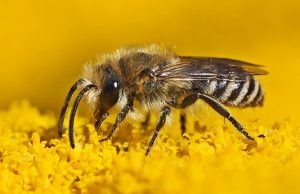19
Mar
Not Just Bumble and Honey: Ground Nesting Bees Impaired by Neonicotinoid Exposure
 (Beyond Pesticides, March 19, 2019) Research is beginning to explain how systemic neonicotinoid insecticides affect often overlooked species of ground nesting bees. While much of the current scientific literature has focused on the impacts of pesticides to bumblebees and honey bees, a study, Chronic contact with realistic soil concentrations of imidacloprid affects the mass, immature development speed, and adult longevity of solitary bees, recently published in Scientific Reports, confirms that wild, soil-dwelling bees are at similar risk. As policy makers consider ways to protect pollinators, this research finds that uncontaminated soil is an important aspect of ensuring the health of wild, native bees.
(Beyond Pesticides, March 19, 2019) Research is beginning to explain how systemic neonicotinoid insecticides affect often overlooked species of ground nesting bees. While much of the current scientific literature has focused on the impacts of pesticides to bumblebees and honey bees, a study, Chronic contact with realistic soil concentrations of imidacloprid affects the mass, immature development speed, and adult longevity of solitary bees, recently published in Scientific Reports, confirms that wild, soil-dwelling bees are at similar risk. As policy makers consider ways to protect pollinators, this research finds that uncontaminated soil is an important aspect of ensuring the health of wild, native bees.
“This is an important piece of work because it’s one of the first studies to look at realistic concentrations of pesticides that you would find in the soil as a route of exposure for bees,” said Nick Anderson, co-author of the study. “It’s a very under-explored route, especially for some of the more solitary species that nest in the ground.”
In order to study the impact of neonicotinoids on ground nesting bees, researchers used orchard mason bees and leafcutter bees as proxies, as they are easier to gather and rear in the lab, and have a similar ecology to ground nesting species. Roughly 300 bees of each species were taken into the lab as larva, and exposed every 48 hours to either 7.5, 15, or 100 ppb of the neonicotinoid imidacloprid. A control with no exposure was also established as a baseline. The authors explain that these amounts represent realistic exposure patterns that wild bees are likely to encounter in soil.
Researchers monitored the bees every day until they reached adulthood, recording longevity, development speed, and mass. Results show that male and female bees have different reactions to exposure. Female mason bees subject to the highest concentrations of imidacloprid live much shorter lives than those unexposed, while the authors had difficulty determining effects on male bees due to an equipment malfunction. Male leafcutter bees actually lived longer than control bees, but developed much faster and to a smaller size than bees not exposed to a pesticide. Female leafcutter development appeared to depend on the concentration of exposure, with the 15ppb group developing slower than other treatment levels and the 100ppb group developing two days faster than control bees.
The changes are likely a result of a hormetic response by the pollinators. This is a phenomena that results from exposure to pesticides; changes in development occur in order to compensate for energy the bee diverts into physical and biological protections from pesticide exposure. This has important implications for the long term health of ground-nesting bees. Any change in development that distracts or alters normal functioning can affect fitness in the field.
Previous research on the environmental fate of neonicotinoids shows that they have the potential to remain in soil from 200 days to as long as 19 years. This means that the type of chronic exposure tested in the current study could occur years or even a decade after an initial pesticide application. Although scientific literature on wild pollinators is limited, past research on mason bees revealed 50% reduced total offspring and a significantly male-biased offspring sex ratio.
The pollinator crisis is broader than honey and bumble bees, and extends not only to native, ground nesting bees but also butterflies and birds. The New York Times has identified the precipitous decline in insect populations over the past several decades as an insect apocalypse.
While bombastic “apocalyptic” language may be criticized for stoking panic and fear, even these warnings have been generally ignored by many policy makers, begging the question of what it will actually take in order to get action on this critical issue. We need to protect not only honey bees, but the wide diversity of native pollinators in order to maintain agricultural production, floral resources, and other ecosystem services that enable our environment, and ultimately human civilization to thrive.
U.S. Representatives Earl Blumenauer, Jim McGovern, and the 33 current cosponsors of the Saving America’s Pollinators Act are listening to these warnings, and have introduced legislation that would substantive address the threats pesticides pose to pollinators. But in order for change to happen, we need a significant outpouring of public support in favor of this proposal. Take action today by urging your member of Congress to cosponsor SAPA. And if you’re also interested in working on this issue in your state or local community, contact Beyond Pesticides at [email protected] or 202-543-5450.
All unattributed positions and opinions in this piece are those of Beyond Pesticides.
Source: University of Illinois Press Release, Scientific Reports (peer reviewed journal)










